Table of Contents
- Plant Kingdom – Members of Kingdom Plantae
- Characteristics of Kingdom Plantae
- Classification of Kingdom Plantae
- Cryptogams and Phanerogams
Plant Kingdom – Members of Kingdom Plantae
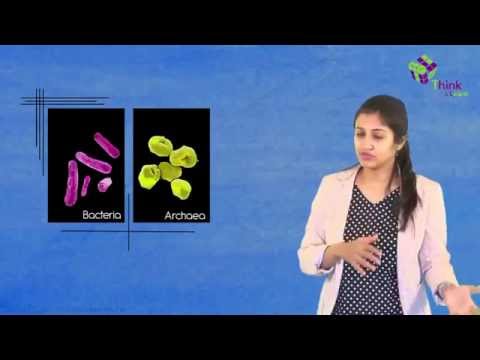
R.H. Whittaker gave the Five Kingdom classification for living organisms. He categorized living organisms based on multiple characteristics such as cellular structure, mode of nutrition, body organization, reproduction, phylogenetic relationship, etc. These five kingdoms were Monera, Protista, Fungi, Plantae and Animalia.
Let’s learn about the plant kingdom, i.e., Kingdom Plantae.
Let us have a detailed look at the plant kingdom notes provided here for the conceptual understanding of the topic.
Also read: Kingdom Animalia, Plantae And Viruses
Plant Kingdom – Plantae
Kingdom Plantae includes all the plants. They are eukaryotic, multicellular and autotrophic organisms. The plant cell contains a rigid cell wall. Plants have chloroplast and chlorophyll pigment, which is required for photosynthesis.
Characteristics of Kingdom Plantae
The plant kingdom has the following characteristic features:
- They are non-motile.
- They make their own food and hence are called autotrophs.
- They reproduce asexually by vegetative propagation or sexually.
- These are multicellular eukaryotes. The plant cell contains the outer cell wall and a large central vacuole.
- Plants contain photosynthetic pigments called chlorophyll present in the plastids.
- They have different organelles for anchorage, reproduction, support and photosynthesis.
Explore More: Photosynthesis.
Recommended Video:
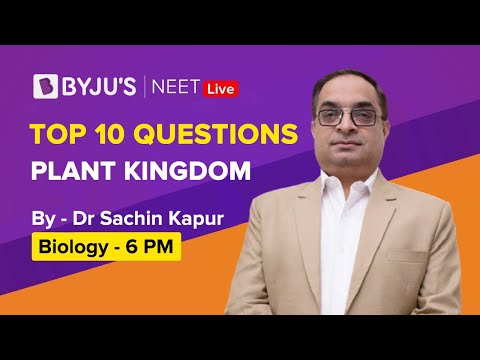
Classification of Kingdom Plantae
A plant kingdom is further classified into subgroups. Classification is based on the following criteria:
- Plant body: Presence or absence of a well-differentiated plant body. E.g. Root, Stem and Leaves.
- Vascular system: Presence or absence of a vascular system for the transportation of water and other substances. E.g. Phloem and Xylem.
- Seed formation: Presence or absence of flowers and seeds and if the seeds are naked or enclosed in a fruit.
More to Read: Seed And Fruit Formation – Seed Dispersal
The plant kingdom has been classified into five subgroups according to the above-mentioned criteria:
- Thallophyta
- Bryophyta
- Pteridophyta
- Gymnosperms
- Angiosperms
Thallophyta
Thallophytes lack a well-differentiated body structure and the plant body is thallus like.
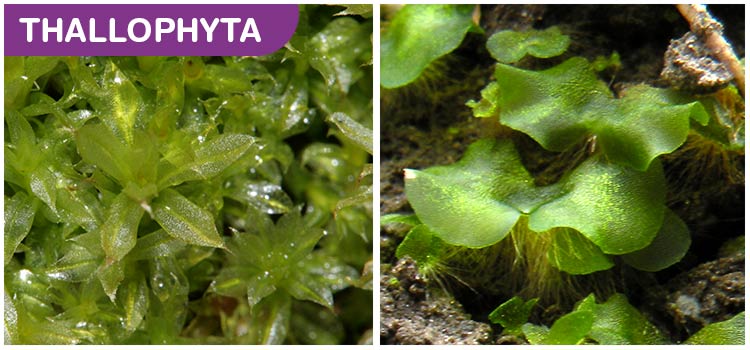
Thallophytes
Thallophyta includes plants with primitive and simple body structures. The plant body is thallus, they may be filamentous, colonial, branched or unbranched. Examples include green algae, red algae and brown algae. Common examples are Volvox, Fucus, Spirogyra, Chara, Polysiphonia, Ulothrix, etc.
Explore More: Thallophytes
Bryophyta
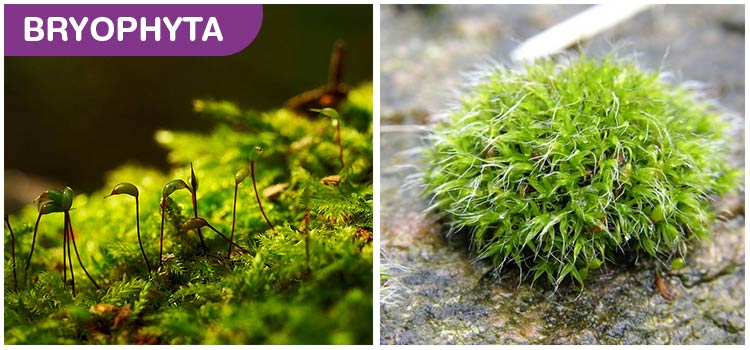
Bryophytes
Bryophytes do not have vascular tissues. The plant body has root-like, stem-like and leaf-like structures. Bryophytes are terrestrial plants but are known as “amphibians of the plant kingdom” as they require water for sexual reproduction. They are present in moist and shady places. Bryophyta includes mosses, hornworts and liverworts. Some of the common examples are Marchantia, Funaria, Sphagnum, Antheoceros, etc.
Extended Reading: Bryophyta
Pteridophyta
Pteridophytes have a well-differentiated plant body into root, stem and leaves. They have a vascular system for the conduction of water and other substances. Some of the common examples are Selaginella, Equisetum, Pteris, etc.
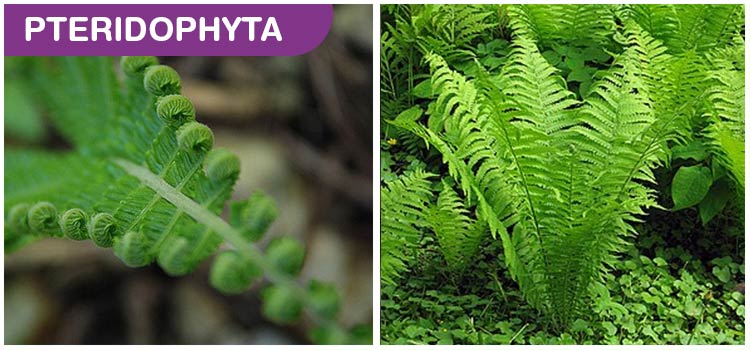
Pteridophytes
More Details: Pteridophyta
Gymnosperms
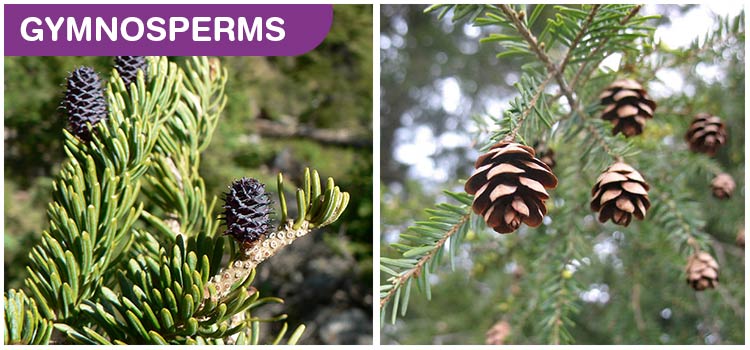
Gymnosperms: Vascular plants that possess “exposed” seeds
Gymnosperms have a well-differentiated plant body and vascular tissues. They bear naked seeds, i.e. seeds are not enclosed within a fruit. Some of the common examples of gymnosperms are Cycas, Pinus, Ephedra, etc.
Angiosperms
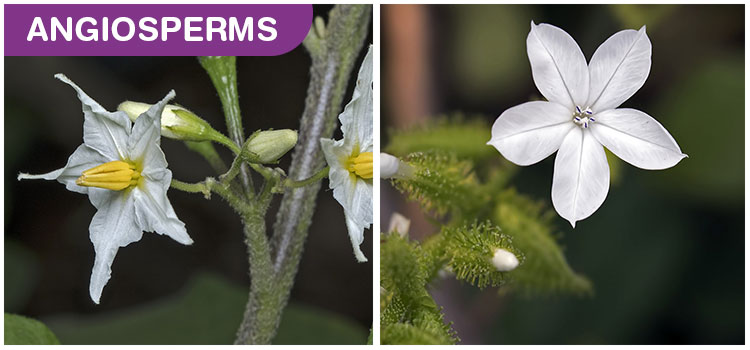
Angiosperms: Vascular plants that possess special characteristics such as flowers and fruits
Angiosperms are seed-bearing vascular plants with a well-differentiated plant body. The seeds of angiosperms are enclosed within the fruits. Angiosperms are widely distributed and vary greatly in size, e.g. Wolffia is small measuring about 0.1 cm and Eucalyptus trees are around 100 m tall. Angiosperms are further divided into monocotyledons and dicotyledons according to the number of cotyledons present in the seeds. Some of the common examples are mango, rose, tomato, onion, wheat, maize, etc.
Further Reading: Angiosperms
Cryptogams and Phanerogams
The plant kingdom is also classified into two groups:
Cryptogams – Non-flowering and non-seed bearing plants. E.g. Thallophyta, Bryophyta, Pteridophyta
Phanerogams – Flowering and seed-bearing plants. E.g. Gymnosperms, Angiosperms
Also Read: Difference Between Bryophytes and Pteridophytes
To learn more about plant kingdom Class 11, its characteristics and classification, explore BYJU’S biology.
Frequently Asked Questions
Name the pigment responsible for photosynthesis in plants.
Chlorophyll is the pigment responsible for photosynthesis in plants.
Describe the criteria for levels of classification in plants.
The plant kingdom is further classified based on the following three criteria:
- Plant body
- Vascular system
- Seed formation
Explain the characteristic of Thallophytes.
Members of this class lack a well-differentiated body structure, or in other words, the body is not clearly divided into stem, leaves and roots.
Explain the significant features of Gymnosperms.
Gymnosperms include plants that possess a vascular system and a well-differentiated body structure. Furthermore, they bear seeds like the angiosperms, but they are not encased within a fruit. Hence, the term “Gymnosperm”, which is derived from Greek word, gymno = naked and Sperma = seed.
List the characteristics of Angiosperms.
- Seed-bearing plants
- Seeds are enclosed within fruits
- Presence of well-differentiated plant body
- Produce flowers during their lifespan
- Presence of two subtypes – monocots and dicots
Register at BYJU’S for more plant kingdom notes for reference.

Thank You!!!!
Lovely information! 😉
Tq for the useful information in a breif
Tremendous information🖒
Thank You! Great Info!
Thank so much ,it is very great
Thank you so much. It really helped me.
Thank you!
Great summary!!!
Thanks:)
This is so Helpful
Thank u ma’am ur explainion is great
Thanks it was helpful I’ll probably visit this website again later
Thanks mam it was a great help for me to complete my project.
Thanks you for the information it was really helpful for me
Hi,the information that you provide are so helpful in my research finding
Nice 👌👌Information.
Yes the answer is mentioned above is very helpful
Very helpful to me.
Thanks for great information
Thank you so much
Thank you so much; it seems very helpful
Thanks for the information well explained more appreciation
Thank you so much, very helpful
More of it
Thank you! I love this information.
Such a amazing notes . I am thankful of u.
Thanks mam for such a great help!
Thank you Ma’am for the beautiful explanation
That’s great really appreciate, ma’am
Thanks for helping
thank you so much
10 characteristics of plantae
The content provided is well elaborated and easy to understand, thanks I appreciate
Such superb info! It helped me a lot thanks a lot
Thank you so much
This is very helpful and important for all students. I got to learn from here. Thanks.
Thanks so much byjus